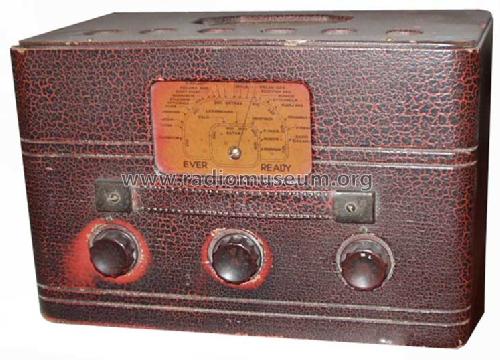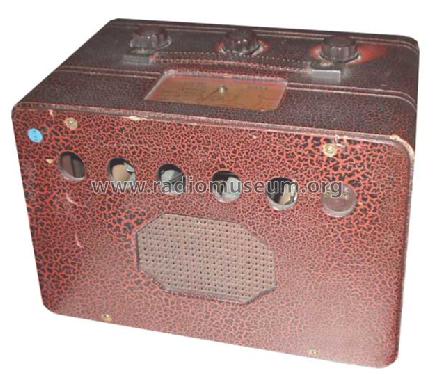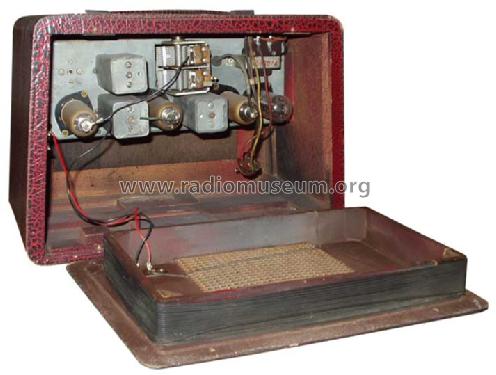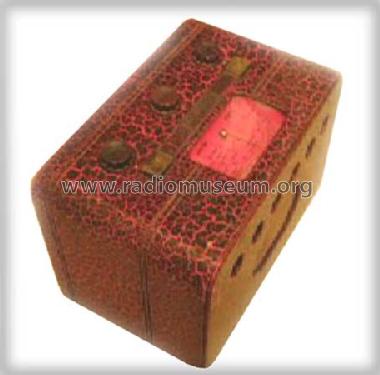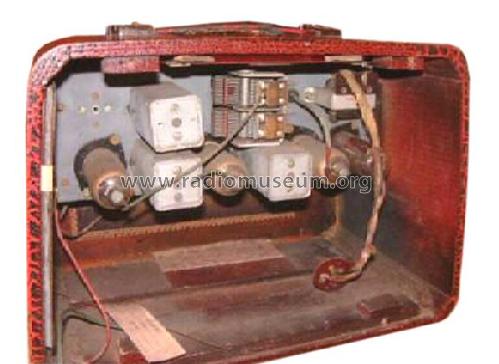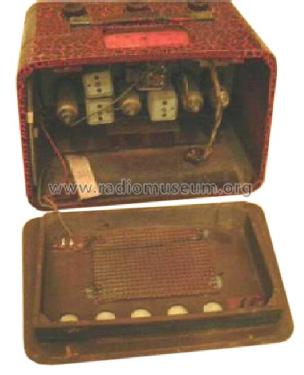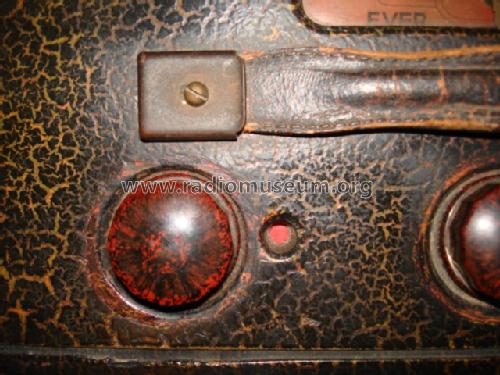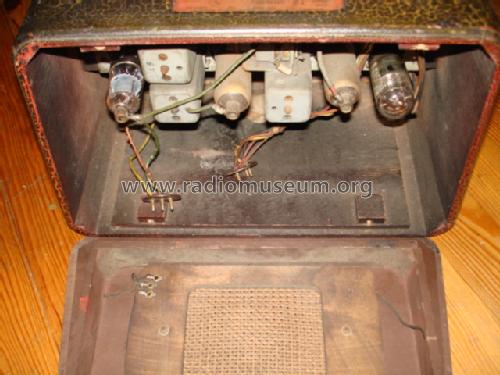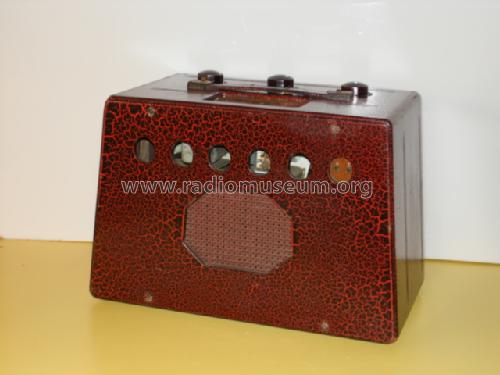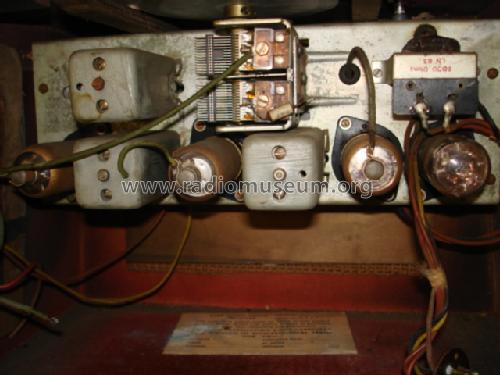All dry Battery Portable 5214 early
Ever Ready Co. (GB) Ltd.; London
- Country
- Great Britain (UK)
- Manufacturer / Brand
- Ever Ready Co. (GB) Ltd.; London
- Year
- 1939
- Category
- Broadcast Receiver - or past WW2 Tuner
- Radiomuseum.org ID
- 70537
Click on the schematic thumbnail to request the schematic as a free document.
- Number of Tubes
- 4
- Main principle
- Superheterodyne (common); ZF/IF 452 kHz
- Wave bands
- Broadcast (MW) and Long Wave.
- Power type and voltage
- Dry Batteries / 1.5/90 Volt
- Loudspeaker
- Permanent Magnet Dynamic (PDyn) Loudspeaker (moving coil)
- Material
- Leather / canvas / plastic - over other material
- from Radiomuseum.org
- Model: All dry Battery Portable 5214 [early] - Ever Ready Co. GB Ltd.; London
- Shape
- Portable set > 8 inch (also usable without mains)
- Dimensions (WHD)
- 12.5 x 8.5 x 11 inch / 318 x 216 x 279 mm
- Notes
-
How to distinguish early and later variant from each other:
This early model has provision to connect external aerial and earth at the very right hand hole in the back plate. There are 6 elliptic holes in the back plate, each ca. 1" wide and 1 1/4" high. The front is clean without visible screw heads (as seen at the late model). The dial pointer is rotating in counter-direction to the tuning knob. For the late model that was revised.
Red/black leatherette finish. See also the 5215 model (gold/black leatherette) and the 5216 model (blue/black leatherette). The 5218 model has a similar chassis and has a larger cabinet and loudspeaker. During WW2 tube shortage above tube types were step by step replaced by (US) octal types 1A7 1N5 1H5 1C5 (and their sockets accordingly). See later models. There are different designs of the wooden case of the 5214.See also the Forces Entertainment Radio.
- External source of data
- Konrad Birkner
- Mentioned in
- -- Collector info (Sammler)
- Literature/Schematics (1)
- Radio! Radio!
- Literature/Schematics (2)
- Trader Service Sheet (suppl. of Wireless & El. Trader, etc.) (450)
- Author
- Model page created by Konrad Birkner † 12.08.2014. See "Data change" for further contributors.
- Other Models
-
Here you find 204 models, 146 with images and 92 with schematics for wireless sets etc. In French: TSF for Télégraphie sans fil.
All listed radios etc. from Ever Ready Co. (GB) Ltd.; London
Collections
The model All dry Battery Portable is part of the collections of the following members.
Forum contributions about this model: Ever Ready Co. GB: All dry Battery Portable 5214
Threads: 2 | Posts: 10
1940 stiftete Lord Nuffield über 1500 dieser Geräte im Wert von £ 15000 für die englischen Truppen in Frankreich (British Expeditionary Forces), um den Soldaten eine Verbindung zur Heimat zu geben.
Ein Äquivalent zu unseren Truppenbetreuungsempfängern, also kein militärisches Gerät.
BBC sendete dafür ein eigenes "Forces Program" auf mehreren Frequenzen der Mittelwelle:
Ab 7.Januar 1940 abends nach 18h auf 342,1 m (tagsüber vom Home Service benützt);
Ab 18. Februar dann von 11h - 23h, tags auf 373,1 m und abends auf 342,1 m;
Ab 17. März dazu der Oversea's Service auf 261,1 m, dessen Programm zusätzlich nach 22h auch auf 373,1 m übertragen wurde.
Quelle: Jonathan Hill, RadioRadio
Gerätetechnik:
Ein normaler Superhet, betrieben aus einer großen Kombinationsbatterie langer Lebensdauer. Eingebaute Rahmenantenne.
Ungewöhnlich die Röhren: 1,4 V D-Typen mit 8 pol. Topfsockel: DK1 DF1 DAC1 DL2. Diese konnten jedoch bald nicht mehr geliefert werden, deshalb wurden die Geräte dann mit Octalfassungen ausgerüstet für die (ursprünglichen) Äquivalenztypen 1A7 1N5 1H5 1C5 aus den USA. Interessanterweise liegt die Pinbelegung beider Röhrenserien in genau der selben Reihenfolge, als hätte man nur den USA-Typen einen anderen Sockel verpasst...
Deshalb gibt es verschiedene Bestückungs-(und damit Sockel-)varianten.
Es gibt noch einen Unterschied: Bei frühen Geräten dreht sich der Skalenzeiger gegenläufig zum Abstimmknopf.
Bei späteren Geräten wurde der Skalentrieb geändert, so dass nun bei Rechtsdrehung des Knopfes der Zeiger sich ebenfalls nach rechts dreht und umgekehrt. Ob diese Änderung technisch, wirtschaftlich, ergonomisch oder ästhetisch bedingt war, ist unbekannt.
Die genaue Typenzuordnung ist noch nicht vollständig geklärt.
Soweit bisher bekannt handelte es sich dabei nur um verschiedene Gehäuseoberflächen :
5214 rot/schwarz
5215 gold/schwarz
5216 blau/schwarz
von der fliegerblauen Variante ist keine genaue Bezeichnung bekannt.
Man geht vorläufig von einer Variante zu 5214 aus
5217 und 5218 waren Tischgeräte mit größerem Gehäuse und Lautsprecher.
Konrad Birkner † 12.08.2014, 31.Aug.07
In 1940 over 1500 of these Ever Ready All Dry Portables were bought from a fund of 15,000£ given by Lord Nuffield. The radios were shipped to the British Expeditionary Forces (B.E.F.) in France. This would enable the B.E.F. to listen in to the BBC Forces Program.
On January 7th 1940 an experimental BBC program was started at 6pm on 342.1 metres (the wave being used by the Home Service during the day).
On February 18th it became a full daily programme from 11am to 11pm on 373.1 m during the day and on 342.1 m during the evening.
From March 17th on 261.1 m the BBC's Overseas Service was added, which was also put out after 10pm on the 373.1 m wave.
Ref.: Jonathan Hill, RadioRadio
Technology:
Standard Superhet, powered by a huge combination battery for long life. Built in frame aerial.
Unusual valves: 1,4 V side contact types DK1 DF1 DAC1 DL2.
Due to supply shortage these types were gradually replaced by equivalent US octal types 1A7 1N5 1H5 1C5, made by Brimar. The pin allocation follows the same pattern.
Konrad Birkner † 12.08.2014, 28.Aug.07



